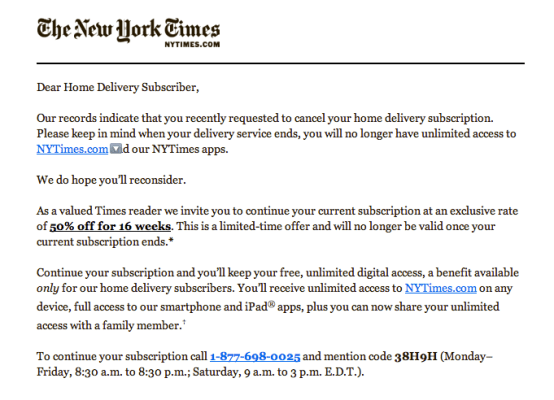If you’re a New York Times subscriber — or even if you’re not — you may have received that following email this morning, implying that you have cancelled your subscription. Many many people did, it’s all over the tweets.
Even though the email was sent from an address that had sent out legitimate emails in the past, “email.newyorktimes.com,” it wasn’t actually from the New York Times, as some of their more tech hipster reporters and their official Twitter account confirmed, “If you received an email today about canceling your NYT subscription, ignore it. It’s not from us.”
Here is the text of the email in question:
Dear Home Delivery Subscriber,
Our records indicate that you recently requested to cancel your home delivery subscription. Please keep in mind when your delivery service ends, you will no longer have unlimited access to NYTimes.com and our NYTimes apps.
We do hope you’ll reconsider.
As a valued Times reader we invite you to continue your current subscription at an exclusive rate of 50% off for 16 weeks. This is a limited-time offer and will no longer be valid once your current subscription ends.*
Continue your subscription and you’ll keep your free, unlimited digital access, a benefit available only for our home delivery subscribers. You’ll receive unlimited access to NYTimes.com on any device, full access to our smartphone and iPad® apps, plus you can now share your unlimited access with a family member.†
To continue your subscription call 1-877-698-0025 and mention code 38H9H (Monday–Friday, 8:30 a.m. to 8:30 p.m.; Saturday, 9 a.m. to 3 p.m. E.D.T.).
So what happened? Most likely a case of email header spoofing. Those with the wrong motivations can tweak the “from” field in an e-mail pretty easily. So what’s the NYT IT department doing right now? Probably tracking down all the “spoof” e-mail IPs and fielding a lot of phone calls.
Meanwhile some users are independently reporting that the spoof email IPs belong to Epsilon, an email firm that the New York Times uses that just so happened to be hacked last spring. While many are leaning towards the hack theory to explain this morning’s confusion, it’s also possible that someone at Epsilon dun goofed and did something silly like hit “reply all.”
Update: Wow, this story is getting even more cray; New York Times media reporter Amy Chozick claims that email came from a Times employee, “not employed by outside firm Epsilon,” according to a spokeswoman. It should have gone to approximately 300 people and went to over 8 million, Chozick just tweeted.
https://twitter.com/#!/amychozick/status/152128299160702976
Update 2: The New York Times confirms that the email was an internal mistake in a statement.
“An email was sent earlier today from The New York Times in error. This email should have been sent to a very small number of subscribers, but instead was sent to a vast distribution list made up of people who had previously provided their email address to The New York Times. We regret this error and we regret our earlier communication noting that this email was SPAM.”
In any case, all this confusion has made for some choice Twitter hilarity.
https://twitter.com/#!/pourmecoffee/status/152140801495937024
https://twitter.com/#!/NYTimesComm/status/152099060248092672
https://twitter.com/#!/pkafka/status/152104392575827968
https://twitter.com/#!/nickbilton/status/152102323886358529
https://twitter.com/#!/alexia/status/152102542598356992
https://twitter.com/#!/eslawiniplant/status/152105975862665216
https://twitter.com/#!/Megan/status/152109112321257472
https://twitter.com/#!/alexia/status/152114560696983553
https://twitter.com/#!/pbump/status/152113034301673472
https://twitter.com/#!/NYTSpam/status/152109822450466816
